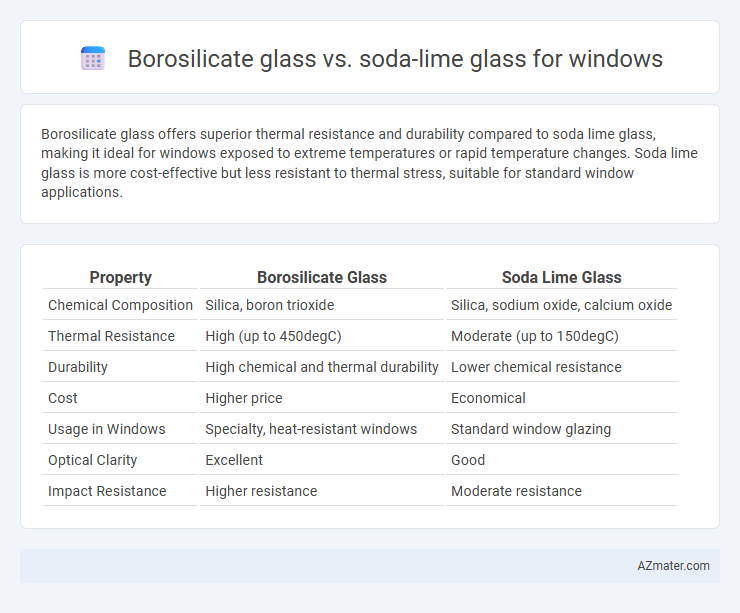Borosilicate glass offers superior thermal resistance and durability compared to soda lime glass, making it ideal for windows exposed to extreme temperatures or rapid temperature changes. Soda lime glass is more cost-effective but less resistant to thermal stress, suitable for standard window applications.
Table of Comparison
| Property | Borosilicate Glass | Soda Lime Glass |
|---|---|---|
| Chemical Composition | Silica, boron trioxide | Silica, sodium oxide, calcium oxide |
| Thermal Resistance | High (up to 450degC) | Moderate (up to 150degC) |
| Durability | High chemical and thermal durability | Lower chemical resistance |
| Cost | Higher price | Economical |
| Usage in Windows | Specialty, heat-resistant windows | Standard window glazing |
| Optical Clarity | Excellent | Good |
| Impact Resistance | Higher resistance | Moderate resistance |
Introduction to Glass Types for Windows
Borosilicate glass, known for its high thermal resistance and durability, is ideal for windows exposed to extreme temperature changes or harsh environmental conditions. Soda lime glass, the most common type used in standard window applications, offers cost-effective transparency and sufficient strength for everyday residential and commercial use. Selecting between these glasses depends on factors such as thermal stability, budget, and specific window performance requirements.
What is Borosilicate Glass?
Borosilicate glass, a type of glass composed primarily of silica and boron trioxide, offers superior thermal resistance and durability compared to soda lime glass, making it ideal for windows exposed to extreme temperatures or rapid thermal changes. In contrast, soda lime glass, which is the most common type used in window panes, consists mainly of silica, soda, and lime and is less resistant to thermal stress and chemical corrosion. The chemical stability and low coefficient of thermal expansion in borosilicate glass result in enhanced longevity and performance in demanding environmental conditions.
What is Soda Lime Glass?
Soda lime glass is the most common type of glass used in windows, composed primarily of silica, soda (sodium oxide), and lime (calcium oxide), offering an affordable and versatile solution. It provides decent optical clarity and durability but has lower thermal resistance and chemical stability compared to borosilicate glass. Due to its cost-effectiveness and ease of manufacturing, soda lime glass remains the preferred choice for standard residential and commercial window applications.
Key Chemical Differences
Borosilicate glass contains high levels of silica and boron oxide, enhancing its thermal resistance and chemical durability compared to soda lime glass, which primarily consists of silica, sodium oxide, and calcium oxide. The presence of boron oxide in borosilicate glass reduces its coefficient of thermal expansion to about 3.3 x 10^-6 /degC, making it less prone to thermal shock, whereas soda lime glass typically has a higher coefficient around 9 x 10^-6 /degC. This key chemical difference results in borosilicate glass being more suitable for windows exposed to extreme temperature variations or harsh environmental conditions.
Strength and Durability Comparison
Borosilicate glass exhibits superior strength and durability compared to soda lime glass due to its low thermal expansion coefficient of approximately 3.3 x 10-6 /degC, reducing the risk of cracking under temperature fluctuations. In contrast, soda lime glass has a higher thermal expansion (around 9 x 10-6 /degC), making it more susceptible to thermal stress and breakage. The chemical durability of borosilicate glass also surpasses soda lime glass, offering enhanced resistance to chemical corrosion and prolonged lifespan in window applications.
Thermal Resistance: Borosilicate vs Soda Lime
Borosilicate glass offers superior thermal resistance compared to soda lime glass, with a coefficient of thermal expansion around 3.3 x 10-6 /degC, enabling it to withstand rapid temperature changes without cracking. Soda lime glass, commonly used in windows, has a higher thermal expansion coefficient near 9 x 10-6 /degC, making it more prone to thermal stress and breakage under fluctuating temperatures. This makes borosilicate glass ideal for applications requiring enhanced durability and thermal stability in window installations exposed to extreme temperature variations.
Optical Clarity and Light Transmission
Borosilicate glass offers superior optical clarity and higher light transmission compared to soda lime glass due to its low iron content and uniform composition, making it ideal for windows requiring enhanced visibility and minimal distortion. Soda lime glass, while more cost-effective, typically exhibits lower light transmittance and higher levels of impurities that can reduce clarity and cause slight color tinting. For applications prioritizing maximum natural light and clear views, borosilicate glass outperforms standard soda lime glass in both purity and performance.
Cost and Availability
Borosilicate glass is more expensive than soda lime glass due to its superior thermal resistance and durability, making it less common for standard window applications. Soda lime glass dominates the market for windows because it is cost-effective and widely available, produced in large quantities globally. Availability of borosilicate glass is limited and primarily reserved for specialized uses, whereas soda lime glass is the default choice for residential and commercial window installations.
Recommended Uses in Window Applications
Borosilicate glass is highly recommended for window applications requiring superior thermal resistance and durability, such as in laboratory settings, industrial environments, and areas exposed to temperature fluctuations. Soda lime glass, commonly used in standard residential and commercial windows, offers good clarity and cost-effectiveness but lacks the enhanced heat resistance of borosilicate. For windows subjected to harsh weather, thermal shock, or chemical exposure, borosilicate glass provides long-lasting performance and safety benefits over soda lime glass.
Which Glass is Best for Your Windows?
Borosilicate glass offers superior thermal resistance and durability compared to soda lime glass, making it ideal for windows exposed to extreme temperatures or frequent thermal stress. Soda lime glass is more affordable and widely used in standard residential windows but lacks the enhanced strength and chemical resistance of borosilicate glass. Choosing borosilicate glass ensures longer-lasting clarity and reduced risk of cracking, especially in harsh environments, while soda lime glass suits budget-conscious projects with moderate performance demands.

Infographic: Borosilicate glass vs Soda lime glass for Window
 azmater.com
azmater.com